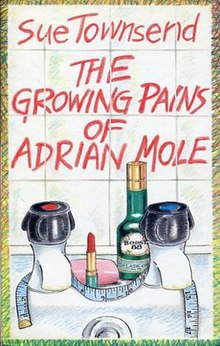The Growing Pains of Adrian Mole

First edition
|
|
| Author | Sue Townsend |
|---|---|
| Country | United Kingdom |
| Language | English |
| Series | Adrian Mole series |
| Genre | Young adult novel |
| Publisher | Puffin Books / Methuen |
|
Publication date
|
2 August 1984 |
| Media type | Print (Hardback & Paperback) |
| Pages | 160 |
| ISBN | |
| OCLC | 59195255 |
| Preceded by | The Secret Diary of Adrian Mole, Aged 13¾ |
| Followed by | The True Confessions of Adrian Albert Mole |
The Growing Pains of Adrian Mole, a novel by Sue Townsend, is the 2nd book in the Adrian Mole series, following on from The Secret Diary of Adrian Mole, Aged 13¾. It focuses on the worries and regrets of a teenage aspiring intellectual. The novel is included in the omnibus Adrian Mole: From Minor to Major.
The book is written in a diary style and set in 1982 through to mid-1983. Notable events in this volume are the breakup and later reconciliation of Adrian and Pandora, Adrian's attempt to run away from home and subsequent breakdown, the birth of his sister Rosie Mole, and Adrian's general worry about his O levels and nuclear war.
Adrian Mole is an outsider who feels the reason he can't quite fit in with "regular" society is that he is an intellectual. Evidence from his diary entries include a precocious interest in literature, in left-wing politics, a desire to have his own poetry show on the BBC, his dislike of Margaret Thatcher and his frequent critiques of his less-refined schoolmates and family. Adrian's dysfunctional family, as in The Secret Diary of Adrian Mole, is one of the focal points of the book.
Although portrayed as somewhat vain and self-centred, Adrian is the only friend and frequent caretaker of the OAP Bert Baxter, and also shows a great deal of concern and compassion for the misfortunes of his parents and respect for the authority of his grandmother.
This book builds on its predecessor by continuing the storyline of Adrian's growing frustration with his body. He constantly writes about the "spots" that mar his complexion, and he also has self-esteem issues about his height and muscular maturity.
Reviewing the book for The Financial Times, Martin Seymour-Smith wrote that it was "quite as classic" as its predecessor.
...
Wikipedia
